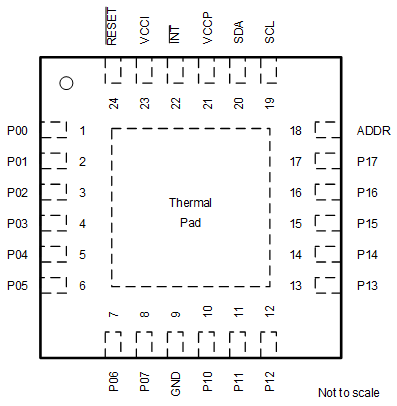SCPS276D June 2022 – January 2025 TCAL6416
PRODUCTION DATA
- 1
- 1 Features
- 2 Applications
- 3 Description
- 4 Pin Configuration and Functions
- 5 Specifications
- 6 Parameter Measurement Information
- 7 Detailed Description
- 8 Application and Implementation
- 9 Device and Documentation Support
- 10Revision History
- 11Device and Documentation Support
- 12Mechanical, Packaging, and Orderable Information
Package Options
Mechanical Data (Package|Pins)
Thermal pad, mechanical data (Package|Pins)
- RTW|24
Orderable Information
4 Pin Configuration and Functions
 Figure 4-1 PW Package, 24-Pin TSSOP
(Top View)
Figure 4-1 PW Package, 24-Pin TSSOP
(Top View) Figure 4-2 DGS Package, 24-Pin VSSOP (Top View)
Figure 4-2 DGS Package, 24-Pin VSSOP (Top View)
The exposed center pad must be connected as a secondary ground or left
electrically open.
Figure 4-3 RTW Package, 24-Pin WQFN
(Top View)Table 4-1 Pin Functions
| PIN | TYPE | DESCRIPTION | |||
|---|---|---|---|---|---|
| NAME | TSSOP (PW) |
VSSOP (DGS) |
QFN (RTW) |
||
| INT | 1 | 1 | 22 | O | Interrupt output. Connect to VCCI or VCCP through a pull-up resistor |
| VCCI | 2 | 2 | 23 | — | Supply voltage of I2C bus. Connect directly to the supply voltage of the external I2C controller |
| RESET | 3 | 3 | 24 | I | Active-low reset input. Connect to VCCI through a pull-up resistor, if no active connection is used |
| P00 | 4 | 4 | 1 | I/O | P-port input/output (push-pull design structure). At power on, P00 is configured as an input |
| P01 | 5 | 5 | 2 | I/O | P-port input/output (push-pull design structure). At power on, P01 is configured as an input |
| P02 | 6 | 6 | 3 | I/O | P-port input/output (push-pull design structure). At power on, P02 is configured as an input |
| P03 | 7 | 7 | 4 | I/O | P-port input/output (push-pull design structure). At power on, P03 is configured as an input |
| P04 | 8 | 8 | 5 | I/O | P-port input/output (push-pull design structure). At power on, P04 is configured as an input |
| P05 | 9 | 9 | 6 | I/O | P-port input/output (push-pull design structure). At power on, P05 is configured as an input |
| P06 | 10 | 10 | 7 | I/O | P-port input/output (push-pull design structure). At power on, P06 is configured as an input |
| P07 | 11 | 11 | 8 | I/O | P-port input/output (push-pull design structure). At power on, P07 is configured as an input |
| GND | 12 | 12 | 9 | — | Ground |
| P10 | 13 | 13 | 10 | I/O | P-port input/output (push-pull design structure). At power on, P10 is configured as an input |
| P11 | 14 | 14 | 11 | I/O | P-port input/output (push-pull design structure). At power on, P11 is configured as an input |
| P12 | 15 | 15 | 12 | I/O | P-port input/output (push-pull design structure). At power on, P12 is configured as an input |
| P13 | 16 | 16 | 13 | I/O | P-port input/output (push-pull design structure). At power on, P13 is configured as an input |
| P14 | 17 | 17 | 14 | I/O | P-port input/output (push-pull design structure). At power on, P14 is configured as an input |
| P15 | 18 | 18 | 15 | I/O | P-port input/output (push-pull design structure). At power on, P15 is configured as an input |
| P16 | 19 | 19 | 16 | I/O | P-port input/output (push-pull design structure). At power on, P16 is configured as an input |
| P17 | 20 | 20 | 17 | I/O | P-port input/output (push-pull design structure). At power on, P17 is configured as an input |
| ADDR | 21 | 21 | 18 | I | Address input. Connect directly to VCCP or ground |
| SCL | 22 | 22 | 19 | I | Serial clock bus. Connect to VCCI through a pull-up resistor |
| SDA | 23 | 23 | 20 | I/O | Serial data bus. Connect to VCCI through a pull-up resistor |
| VCCP | 24 | 24 | 21 | — | Supply voltage of TCAL6416 for P-ports |